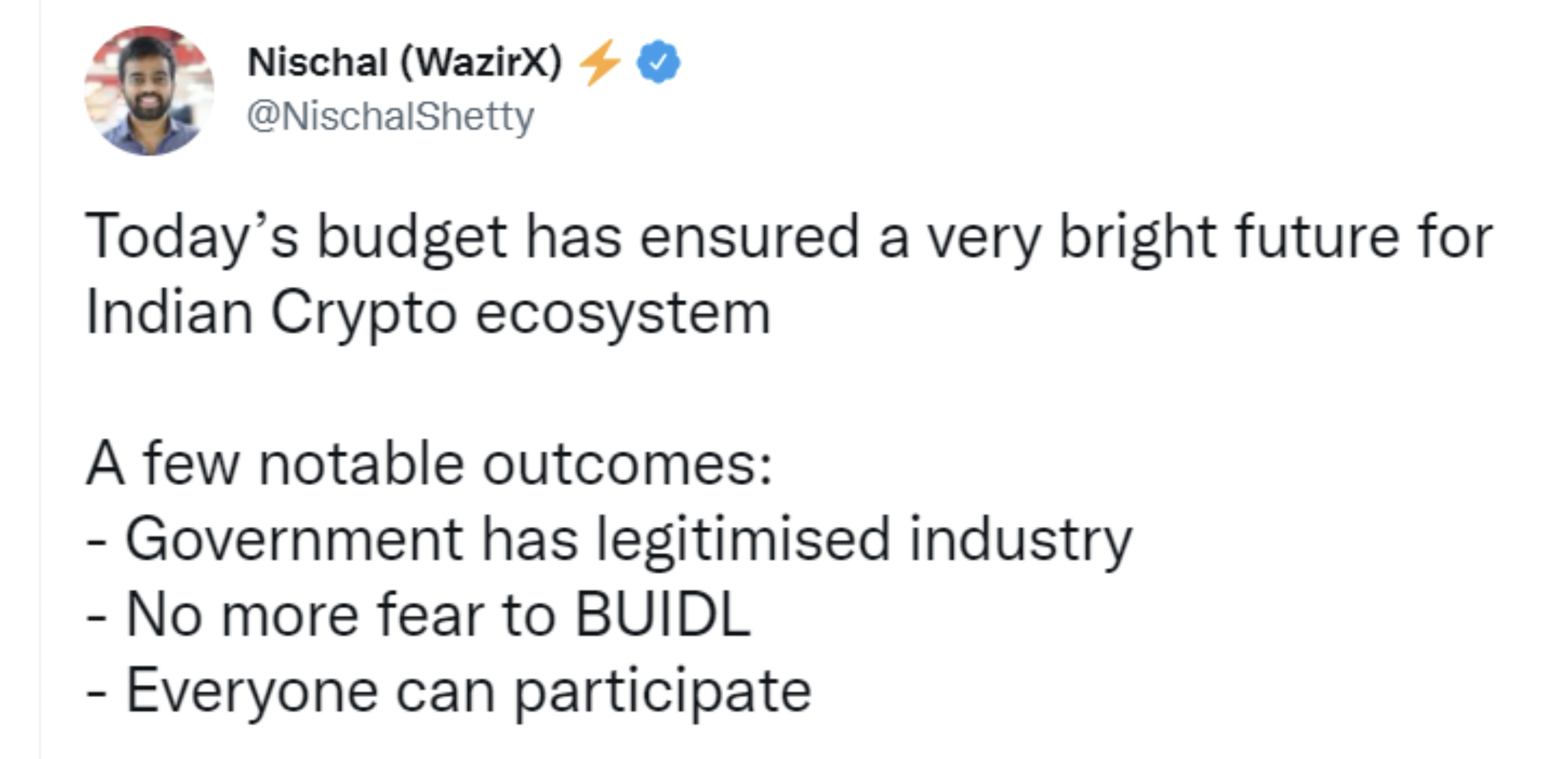India on Tuesday proposed a 30% tax on income from the transfer of virtual digital assets such as cryptocurrencies and NFTs. Government officials said the move was an attempt to take advantage of the high tax rate to effectively remove uncertainty about the legal status of cryptocurrency transactions.
For this policy, the international encryption field and Indian practitioners generally welcome it.
CZ couldn't wait to tweet, "Cryptocurrency is legally recognized in India and needs to pay a 30% tax." The tweet received 53,000 likes and 10,000 retweets.

Nischal Shetty, CEO of WazirX, India's largest exchange, said: "The government's latest encryption plan will promote a bright future for the Indian cryptocurrency ecosystem, bringing several notable results: legalization of the industry, no longer afraid of BUIDL (building blockchain ecology), everyone can participate.”

At the same time, Nischal Shetty cleared up the confusion for everyone, explaining with a concise case that the 30% tax increase in India only increases the tax on the profit part of the investment.
secondary title

From prohibition to tolerance, the attitude of the Indian government has changed
Encryption knows no borders. As a new species of globalization, India also did not miss the several cycles of Bitcoin that went through bull and bear. At the same time, like most countries in the world, the Indian government's attitude towards cryptocurrencies has undergone a transformation from prohibition to tolerance.
From 2013 to 2017, with the sharp rise and fall of Bitcoin, the number of encrypted users in India increased sharply, and many millionaires were born among them.
In October 2016, major Indian bitcoin exchanges added more than 200,000 monthly users. In March 2017, ASSOCHAM, one of the three major industry associations in India, held a global summit on Bitcoin and blockchain, calling Bitcoin "a revolution in the field of supply chain finance." In May 2017, India accounted for nearly 10 percent of global cryptocurrency transactions, according to news site thequint.com.
In May 2017, the demand for bitcoin grew exponentially to the point that India's largest exchange had to limit bitcoin purchases due to insufficient supply.
A month later, in June, Zebpay became the seventh most popular app in the Apple app store in India, surpassing even many state bank apps.
Meanwhile, India's central bank is gradually tightening rules in an attempt to tame the crypto monster.
The Reserve Bank of India, the central bank's equivalent, has been warning users of cryptocurrencies since 2013, arguing that cryptocurrencies are a form of digital payment that must be banned lest the country's payments system be jeopardized.
Until April 2018, India issued a policy prohibiting regulated banks and financial institutions from providing services to cryptocurrency exchanges. The Central Bank of India believes that cryptocurrencies have problems in consumer protection, market integrity and money laundering, which is worrying.
After the ban took effect, exchanges including Zebpay, Coindelta, and Koinex shut down one after another.
However, people in the Indian crypto space believe that cryptocurrencies have grown into a global phenomenon, and the government cannot stop its growth. They might slow it down, but they can't stop it.
On March 5, 2020, after many debates lasting two years, the legal battle between the consortium of Indian cryptocurrency exchanges and the Reserve Bank of India (RBI) finally came to an end, with the Supreme Court overturning the RBI’s ban on trading cryptocurrencies.
secondary title
Prime Time for Crypto Adoption in India Post 2020
After the Supreme Court of India lifted the encryption ban, the Indian encryption ecosystem has fully exerted its strength.
According to Dappros market analysis, as of November 2021, the number of blockchain developers in India has ranked second in the world, second only to the United States, followed by the United Kingdom, Canada and France.
The good technical atmosphere has prompted India to incubate many globally influential projects, including the Layer 2 project Polygon (Matic), the Indian Crypto exchange WazirX, and the Layer 0 expansion protocol Marlin.
The most representative project is undoubtedly Polygon. Jaynti, who was born in Ahmedabad, India's sixth largest city, is the main founder of Polygon. Committed to blockchain scalability, Polygon, a $12 billion Indian unicorn with a market capitalization of $12 billion, has become a major force influencing the scale of global blockchain adoption.
According to Blocklike's previous analysis, the circulation and usage of DApps in India shows that Polygon has ushered in an increase in usage. In a single month, the number of DApps based on Polygon has increased by more than 60, and a quarter of them are from India.
In terms of user scale, the number of registrations of WazirX, an Indian Crypto exchange in India, has increased by 150%, and the transaction volume has increased by 66%. This is only the short-term data at that time. Looking at the long-term period, this growth has continued. Localbitcoins data shows that after April 2020, the trading volume of Crypto P2P in India has started a long-term growth trend.
in conclusion
in conclusion
Encryption has no borders, but regulation has borders. Regulators want to guard against risk, and industries want to innovate. These wishes are not impossible.
The clarity of India's encryption policy may serve as a model for us to tame the "bad boys" of cryptocurrency.